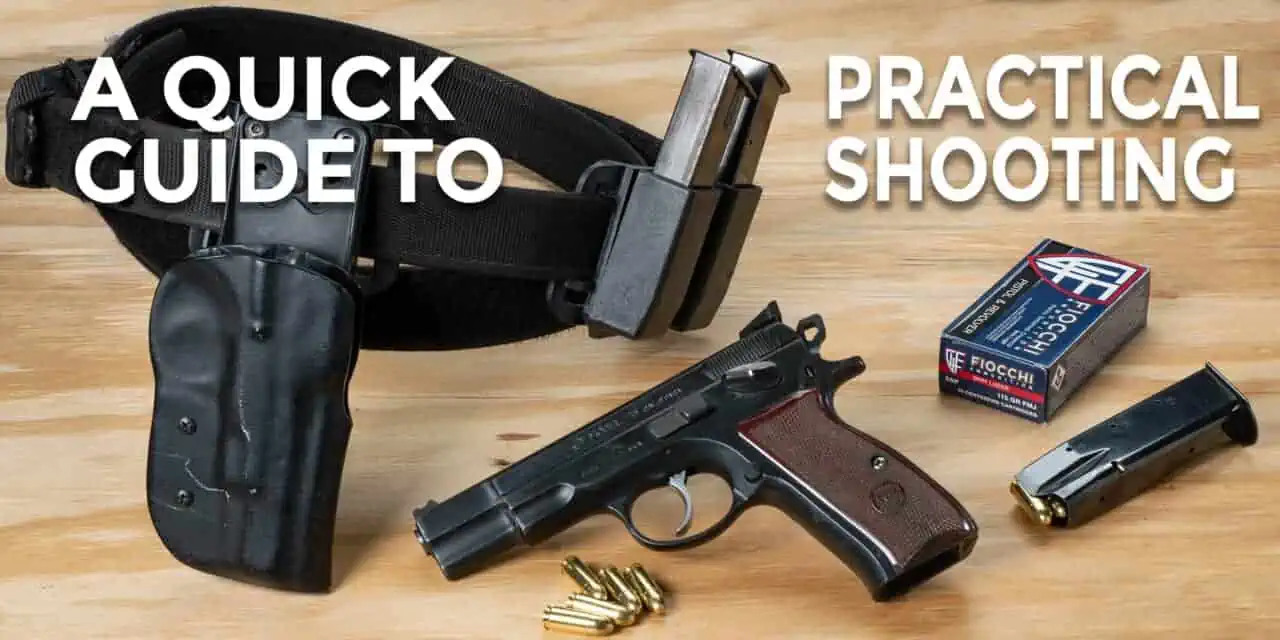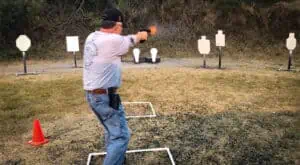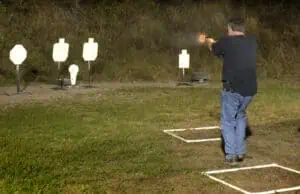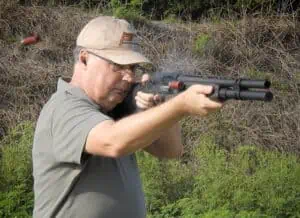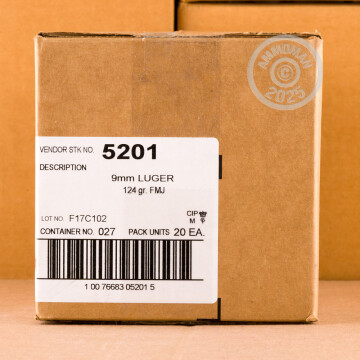Practical Shooting For The First Timer
The history of national-level shooting matches in the U.S. stretches back to after the Civil War. Then, the National Rifle Association was created to host rifle matches as a way to improve the marksmanship of soldiers in the U.S. Army. In 1906, the tradition of using competitive shooting to improve the quality of combat soldiers was passed on to the Civilian Marksmanship Program (CMP), where it continues to this day. A CMP match is a very static event, which favors competitions that bear little or no resemblance to the realities faced by the armed citizens of today. Competitors in a CMP match are not allowed to move with a gun in their hands. The time limits for each match can stretch out long past the time for most civilian defensive encounters.
Enter Colonel Jeff Cooper
This was the competitive landscape that Col. Jeff Cooper was faced with in the years after World War II. Cooper was one of the icons of modern gun culture. He was responsible for creating the Modern Technique of the pistol and founded Gunsite, America’s oldest firearms training school.
Cooper recognized the value of competition as a way to hone combative skill. It is, after all, a tradition that stretches back to the original Olympic games in ancient Greece. They conducted pistol matches of the time in a Bullseye format. Competitors shot at targets 25 or 50 yards away, under very generous time limits.
Cooper realized that accuracy needed to be balanced with speed. So, in 1958 he created the first practical shooting competition, the Leatherslap competition at Big Bear Lake, a California ski resort. The rules for Leatherslap matches changed from year to year, but the match revolved around a simple concept: Two competitors went head-to-head to see who could get the most amount of hits in the shortest amount of time. That simple setup led to the creation of the Weaver Stance and other techniques still in use today. In 1976, it also led to creation of the International Practical Shooting Confederation (IPSC), the first organization dedicated to practical shooting. To gain a better understanding of why Cooper created IPSC and the sport of practical shooting, I asked Ken Campbell, the CEO of Gunsite, about the sport’s origins.
The Sport Evolves
“Jeff Cooper started IPSC as an extension of the Leatherslap shoot,” Campbell said. “The options for shooting matches at the time were bullseye, silhouette and PPC (Police Practical Competitions). None of them resembled what Jeff thought reality really looked like.”
“PPC had drawing and human targets but the sport had evolved to use gear not used by law enforcement officers. Bullseye shooting stressed the theory of accuracy, but not how it applied to the real world. What Col. Cooper created was a sport that bore more resemblance to how people used their guns in a defensive encounter. Moving with a loaded gun was controversial at the time. So, at first, we had stages which had par times and static positions. What was revolutionary was our scoring system. It placed an emphasis on balancing pinpoint accuracy with making shots as quickly as possible. That changed, and we had people running all over the place, doing all sorts of running and jumping as part of the stage.”
The Birth of the International Practical Shooting Confederation
IPSC started out as a way to test the effectiveness of everyday defensive pistols. However, IPSC evolved towards pistols specifically designed for practical shooting competitions. Originally, competitors in an IPSC match shot in the same division, but the advantages one competitor might have with, say, an extended magazine that held more rounds before reloading quickly, led to the creation of separate divisions inside of IPSC. In addition to this, tensions arose between how matches were governed in the U.S. and how they were governed overseas, which led to the United States Practical Shooting Association spinning off from IPSC in the early 80’s. IPSC and the USPSA have almost the same rules, and there is a large amount of overlap between the two sports.
IPSC and USPSA both continued to develop as specialized sports which increasingly deviated from their “practical” origins. “Race guns” which featured feather-light triggers and custom holsters not suitable for daily carry became the norm for some competitors. Just as the lack of practical application led to the creation of IPSC and then USPSA, the increasing disconnect between those sports and the world of the armed citizen led, in 1995, to the founding of the International Defensive Pistol Association, or IDPA. IDPA was created to return practical shooting to its practical roots. Competitors in an IDPA match must draw from concealment, and the effective use of cover while shooting is an important part of winning an IDPA match.
More to the sport than just USPSA, IPSC, and IDPA
There are two other pistol-based practical shooting sports, the Bianchi Cup and Steel Challenge. The Bianchi Cup has four stages (called “Events”) that have not changed since Bianchi Cup’s inception in 1979.
Those four stages are
1.) The Mover, where competitors must shoot at a moving silhouette target from a variety of distances.
2.) The Practical, where competitors have a short amount of time to engage a turning target.
3.) The Falling Plates uses six 6 inch steel plates as targets.
4.) The Barricade, where you engage targets from behind cover.
The scoring in Bianchi Cup is set up to favor speed over accuracy. The scoring in Steel Challenge, on the other hand, is biased towards speed. Like Bianchi Cup, the format for a Steel Challenge match never varies. Unlike Bianchi Cup, which uses a mixture of steel targets and cardboard targets with scoring rings, the targets in Steel Challenge are all steel. Competitors shoot the course of fire five times on each stage. Scorers toss out their slowest score. The stages all require just five rounds, so fast transitions between targets and no missed shots are the name of the game in this contest.
Three times the guns, three times the fun
Practical shooting covers more than just pistol competitions, however. The history of shooting matches in the U.S. started with military rifles. That tradition was picked up once again in the early 1980’s, when Soldier of Fortune magazine began to run “3 gun” matches at a range outside of Las Vegas, Nevada. The match required the use of a pistol, rifle, and shotgun. Match rules limited competitors to guns similar to those in common use by the military.
The Soldier of Fortune match soon split off into other 3 Gun matches that allowed more guns than just military-style guns.
3 Gun requires you to master not just a pistol under the stress of competition but also a rifle and shotgun. Stages in a 3 Gun match may require the use of all three guns or some combination thereof. In 3 Gun, it’s quite typical to start a stage off shooting targets with your pistol, then transition to shooting different targets with a shotgun, and then finish off the stage by shooting a mixture of near and far targets with your rifle. 3 Gun is also unique in that there is not one overarching governing body to the sport. USPSA has rules for 3 Gun, and there are also nationwide 3 Gun Nation matches. Most matches, however, are run using the International Multigun Association Rules, which are then tailored to suit each specific range.
Why Participate in Practical Shooting?
Competition creates stress, which makes simple tasks difficult to perform. What seems easy on the range when you’re by yourself suddenly becomes a Herculean feat when you are forced to perform it on the clock and under the gaze of your peers.
Practical shooting extends this tradition into the modern world of defensive firearms. A match is also a good way to learn how to adjust to a changing environment while engaging targets with a firearm. By learning how to shoot well under the artificial pressure of your friends and a shot timer, you’re teaching your body how to perform under the real stress of a defensive encounter. More than that, though, it’s a fun way to enjoy the right to keep and bear arms with your friends and learn to shoot better while enjoying some time on the range.

